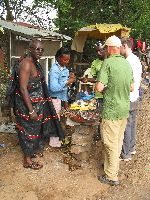|
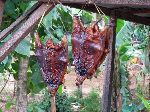
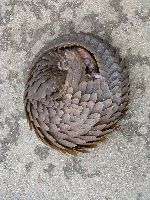 Road
side markets can be entertaining -- sometimes more entertaining than is desirable
when they are selling monkey meat and endangered animals. Fortunately
today's offering was just a splayed and smoked large rodent generally called a
"grass cutter" and a live pangolin, which are the world's only scaly mammals. The
are considered a delicacy in parts of Africa and Asia. In November 2010,
pangolins were added to the Zoological Society of London's list of genetically
distinct and endangered mammals. Road
side markets can be entertaining -- sometimes more entertaining than is desirable
when they are selling monkey meat and endangered animals. Fortunately
today's offering was just a splayed and smoked large rodent generally called a
"grass cutter" and a live pangolin, which are the world's only scaly mammals. The
are considered a delicacy in parts of Africa and Asia. In November 2010,
pangolins were added to the Zoological Society of London's list of genetically
distinct and endangered mammals.
Nkawkaw saddles the Kumasi highway about 150 kilometers northwest of Accra.
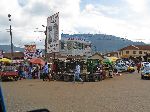
 In
Nkawkaw the streets are for people. There is nothing physically
constraining the vehicles, except there are just too many of the them -- consider it
a self-inflicted traffic calming. So
amidst the gridlock the people go about their business with more speed and
agility than the cars. Unfortunately idling cars have the nasty habit of
poisoning the air, which detracts from an otherwise nice setting. In
Nkawkaw the streets are for people. There is nothing physically
constraining the vehicles, except there are just too many of the them -- consider it
a self-inflicted traffic calming. So
amidst the gridlock the people go about their business with more speed and
agility than the cars. Unfortunately idling cars have the nasty habit of
poisoning the air, which detracts from an otherwise nice setting.
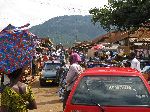
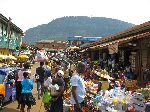
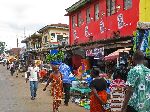
Ghana second largest city and the traditional seat of power of the Ashanti is
Kumasi:
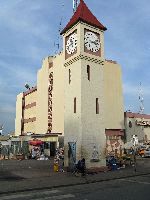 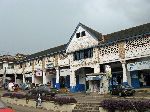 A
lot of
central Kumasi is surprising unchanged in the last one-hundred years: The Donald Stewart
Clock Tower was erected in 1907, there is a commercial building that is dated
1910 and many of the churches in the Adum A
lot of
central Kumasi is surprising unchanged in the last one-hundred years: The Donald Stewart
Clock Tower was erected in 1907, there is a commercial building that is dated
1910 and many of the churches in the Adum
 section of town probably were built in about the same era. They keep moving the
roads around -- often widening them section of town probably were built in about the same era. They keep moving the
roads around -- often widening them
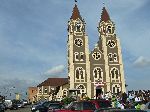 to
accommodate traffic, but sometimes blocking routes to divert traffic, but the
building stock has turned over very little. With a
vision to something other than roads, and some planning, the old physical
history could be pulled together into a historic district that would created a
unifying theme and identity, and preserved the heritage and character of the old town. to
accommodate traffic, but sometimes blocking routes to divert traffic, but the
building stock has turned over very little. With a
vision to something other than roads, and some planning, the old physical
history could be pulled together into a historic district that would created a
unifying theme and identity, and preserved the heritage and character of the old town.
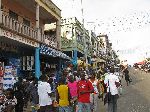
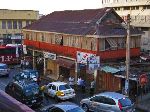
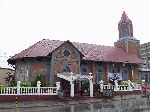
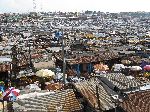 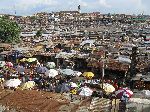 The
dominant feature of Kumasi is the market. Depending upon your source, it is said to be the largest
market in
West Africa, the largest market in sub-Saharan Africa and the largest market in Africa.
Who knows? But it is large. The
dominant feature of Kumasi is the market. Depending upon your source, it is said to be the largest
market in
West Africa, the largest market in sub-Saharan Africa and the largest market in Africa.
Who knows? But it is large.
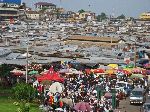 Along
the north edge of the market is a bicycle-street (photo on the left). The
street is filled with bicycles with only a narrow path preserved to walk between
them. Along
the north edge of the market is a bicycle-street (photo on the left). The
street is filled with bicycles with only a narrow path preserved to walk between
them.
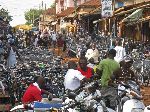 Most
of the bicycles are used -- imported from overseas. The kiosks that line
the street behind to bicycle are filled with parts and accessories. It is
nice Most
of the bicycles are used -- imported from overseas. The kiosks that line
the street behind to bicycle are filled with parts and accessories. It is
nice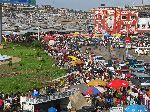 to see the ample supply of hardware to support a bicycle-culture, but there
doesn't seem to be much bicycling being done in Kumasi. Maybe it is hidden
in the suburbs or maybe the merchants are waiting for it to boom. If it is
the latter, I hope
that it is not long in coming and that their patience is sufficient.
to see the ample supply of hardware to support a bicycle-culture, but there
doesn't seem to be much bicycling being done in Kumasi. Maybe it is hidden
in the suburbs or maybe the merchants are waiting for it to boom. If it is
the latter, I hope
that it is not long in coming and that their patience is sufficient.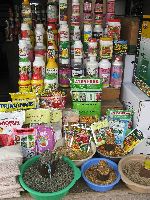
One aspect of the market that was a little spooky was the agro-chemical sellers.
Like most categories of sellers in the market they are somewhat clustered, but
they are also a little interspersed with some food vendors. Some of the
containers of agro-chemicals look almost exactly like the bottle you might buy
fruit juice and other drinks in. Hopefully no children get any of this
confused.
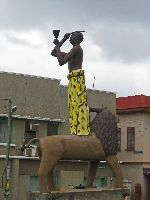 There
are a few nods to heritage around town. A few of the traffic circles have
cultural related sculptures in them, a former fort has been preserved and
converted into a historic/military museum and Kumasi is home to the Ghana
National Culture Centre. The sculpture seen here seems to be a musician or town
crier standing on the back of a lion. We couldn't find any one who could
confirm our interpretation of the content or tell us what the images relates to
in the context of local culture or history. [If you have some information
about this please send it on to us.] There
are a few nods to heritage around town. A few of the traffic circles have
cultural related sculptures in them, a former fort has been preserved and
converted into a historic/military museum and Kumasi is home to the Ghana
National Culture Centre. The sculpture seen here seems to be a musician or town
crier standing on the back of a lion. We couldn't find any one who could
confirm our interpretation of the content or tell us what the images relates to
in the context of local culture or history. [If you have some information
about this please send it on to us.]

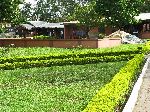 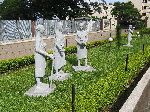
Within the grounds of the Ghana National Culture Centre there are a museum,
library, administrative offices, cafes, performance space, sculpture gardens,
general gardens, working artists and craftsmen, and boutiques selling the
creations of the artists and craftsmen.
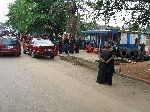
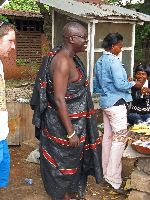 Saturday
(and Sunday) are typically funeral day in Ashanti land. All day as moved
about we say people coming to, attending and leaving from funerals. Women
wore assembles made from black brocade lappas and many men wore black
traditional adinkra cloth. Because it takes a while to get the word out
and organize a big "funeral" these events don't always involve burying the body,
which might have happened sometime earlier. They tend to focus more on
celebrating the life of the deceased. Saturday
(and Sunday) are typically funeral day in Ashanti land. All day as moved
about we say people coming to, attending and leaving from funerals. Women
wore assembles made from black brocade lappas and many men wore black
traditional adinkra cloth. Because it takes a while to get the word out
and organize a big "funeral" these events don't always involve burying the body,
which might have happened sometime earlier. They tend to focus more on
celebrating the life of the deceased.
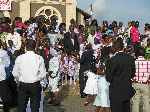
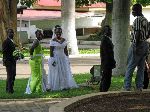 Pleasantly
enough, Saturday is also a popular day for wedding. While exploring the
city there were wedding parties posing for pictures both in front of the
cathedral and in the garden of the National Culture Center. It is now
there good luck to have their images on this website into perpetuity. Pleasantly
enough, Saturday is also a popular day for wedding. While exploring the
city there were wedding parties posing for pictures both in front of the
cathedral and in the garden of the National Culture Center. It is now
there good luck to have their images on this website into perpetuity.
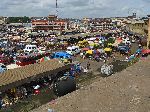  Just like in Europe and North America, you can go to the airport to do your
shopping, in Kumasi bus station you can go to the bus station to do your
shopping. Some of the more common items were plastic bags, bread, beauty
products, and plastic stuff. Just like in Europe and North America, you can go to the airport to do your
shopping, in Kumasi bus station you can go to the bus station to do your
shopping. Some of the more common items were plastic bags, bread, beauty
products, and plastic stuff.
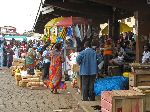
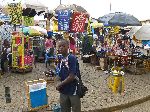
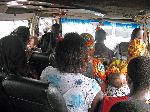
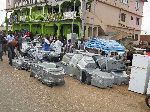 Leaving
Kumasi: the road out of Kumasi is reminiscent of the strip-cities on the
outskirts of towns along the old inter-city highways in America. For more than a
dozen kilometers leading out of Kumasi the roadside was lined with business and
merchandise; appliances, televisions, computers, lamps, tires, and so much more. Leaving
Kumasi: the road out of Kumasi is reminiscent of the strip-cities on the
outskirts of towns along the old inter-city highways in America. For more than a
dozen kilometers leading out of Kumasi the roadside was lined with business and
merchandise; appliances, televisions, computers, lamps, tires, and so much more.
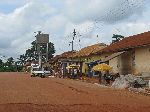
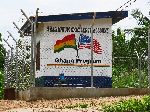 We
left Kumasi to in search of more information on bamboo bikes. The most
active bamboo bike building team in the Kumasi area, works in the village of Yonso, about 40 kilometers north of the Kumasi. Yonso is sort of a
happening place We
left Kumasi to in search of more information on bamboo bikes. The most
active bamboo bike building team in the Kumasi area, works in the village of Yonso, about 40 kilometers north of the Kumasi. Yonso is sort of a
happening place because, besides bamboo bikes, through the Millennium Challenge Account program
it looks like they are getting new water, electricity and road infrastructure.
The Millennium Challenge Account is an initiative to help developing country
that are doing things politically,
because, besides bamboo bikes, through the Millennium Challenge Account program
it looks like they are getting new water, electricity and road infrastructure.
The Millennium Challenge Account is an initiative to help developing country
that are doing things politically,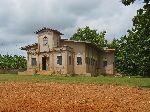 judicially and economically right to boost there economy. A couple other
building that caught the eye of the camera were the solidly built Methodist
Church and Master Kwame's Coffin Shop and its solidly built coffins on display.
judicially and economically right to boost there economy. A couple other
building that caught the eye of the camera were the solidly built Methodist
Church and Master Kwame's Coffin Shop and its solidly built coffins on display.
 The
visit to the Yonso Project gave a much clear picture of the bamboo bicycle
building process. The project director of the Yonso Project gave us a tour.
The bamboo is carefully selected for its diameter and the length of space
between the nodes. Different varieties of bamboo have different
characteristics. One The
visit to the Yonso Project gave a much clear picture of the bamboo bicycle
building process. The project director of the Yonso Project gave us a tour.
The bamboo is carefully selected for its diameter and the length of space
between the nodes. Different varieties of bamboo have different
characteristics. One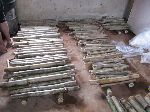 of the tasks of the bamboo bike project is to figure out where they can find the
best bamboo for their purposes, in Ghana.
of the tasks of the bamboo bike project is to figure out where they can find the
best bamboo for their purposes, in Ghana.
An early step for the bamboo is to be soaked in an insecticide (right) -- it
would be a bummer to have your bamboo bike nibbled into dust by insects.
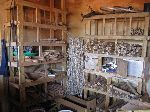
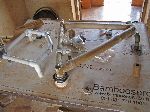 After
the tubing is prepared it is sorted by diameter and length. Each tube on
the bicycle has a specified diameter and length so the sorting makes the
assembly process more efficient. The assembly of the bike is done After
the tubing is prepared it is sorted by diameter and length. Each tube on
the bicycle has a specified diameter and length so the sorting makes the
assembly process more efficient. The assembly of the bike is done
 over a plan. Jigs support
over a plan. Jigs support
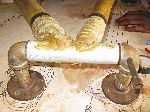 the
aluminum bottom bracket, head tube and a metal gusset in the top of the seat
tube -- the main metal parts of the predominately bamboo frame. Other guides are
also used to insure proper alignment. A bamboo top tube and down tube is then
mitered and the
aluminum bottom bracket, head tube and a metal gusset in the top of the seat
tube -- the main metal parts of the predominately bamboo frame. Other guides are
also used to insure proper alignment. A bamboo top tube and down tube is then
mitered and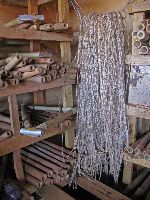
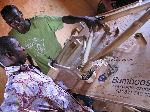 epoxied
to the head tube, and the down tube and seat tube are epoxied to the bottom
bracket. Small diameter seat stays and chain stay are also epoxied on.
These are joined by aluminum rear dropouts. The epoxy used is called epoxied
to the head tube, and the down tube and seat tube are epoxied to the bottom
bracket. Small diameter seat stays and chain stay are also epoxied on.
These are joined by aluminum rear dropouts. The epoxy used is called
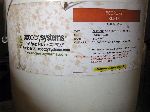 EcoPoxy
Systems. [The company website describes the resin as, "odorless,
*non-toxic, *safe, 100% solid, non-solvent, non-hygroscopic, non-conductive."
The EcoPoxy
Systems. [The company website describes the resin as, "odorless,
*non-toxic, *safe, 100% solid, non-solvent, non-hygroscopic, non-conductive."
The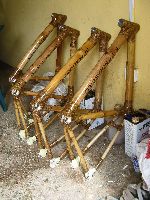 asterisks are theirs but it is not clear what they refer to. There is any
similar information about the hardener, but I will give them the benefit of the
doubt that it is more environmentally friendly than traditional epoxy.] After
the main components of the frame are glued up all of the joints are wrapped or
lashed with epoxy soaked fiber. In the hands of an expert this creates a
very elegant look. There is some additional finishing work, with the final
step being a coat of clear-coat so that the beautiful grain shows through.
The frame builders say they can glue-up and wrap a frame and have it ready for
clear-coat in about four days.
asterisks are theirs but it is not clear what they refer to. There is any
similar information about the hardener, but I will give them the benefit of the
doubt that it is more environmentally friendly than traditional epoxy.] After
the main components of the frame are glued up all of the joints are wrapped or
lashed with epoxy soaked fiber. In the hands of an expert this creates a
very elegant look. There is some additional finishing work, with the final
step being a coat of clear-coat so that the beautiful grain shows through.
The frame builders say they can glue-up and wrap a frame and have it ready for
clear-coat in about four days.
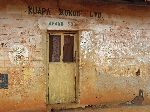
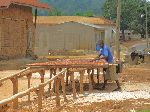 A
second story in Yonso is the spotting of a Kuapa Kokoo building. The
cooperative has "fair-trade certification," and works at improving the social, economic and political wellbeing of
its members. It also sells its beans to and is part owner Divine
Chocolate, so cooperative members benefit from the manufacturing component as
well. There are Kuapa Kokoo branches in villages all around the cocoa
growing region of Ashanti land. A
second story in Yonso is the spotting of a Kuapa Kokoo building. The
cooperative has "fair-trade certification," and works at improving the social, economic and political wellbeing of
its members. It also sells its beans to and is part owner Divine
Chocolate, so cooperative members benefit from the manufacturing component as
well. There are Kuapa Kokoo branches in villages all around the cocoa
growing region of Ashanti land.
 While
Kuapa Kokoo highlights there fair-trade status and effort to do outreach on
practice that can reduce or mitigate global warming, they are silent and don't
make any claims about being organic farmers. In Kumasi there were big
advertising signs for cocoa fertilizers and at CRIG we were told that the use of
fungicide was very common, if not almost universal and necessary. Neither
is proof about the practices of Kuapa Kokoo farmers, but their silence on the
topic raising the questions of how green can cocoa farming be, and for those who
are claiming to produce organic chocolate, how are they achieve it? While
Kuapa Kokoo highlights there fair-trade status and effort to do outreach on
practice that can reduce or mitigate global warming, they are silent and don't
make any claims about being organic farmers. In Kumasi there were big
advertising signs for cocoa fertilizers and at CRIG we were told that the use of
fungicide was very common, if not almost universal and necessary. Neither
is proof about the practices of Kuapa Kokoo farmers, but their silence on the
topic raising the questions of how green can cocoa farming be, and for those who
are claiming to produce organic chocolate, how are they achieve it?
|




















































